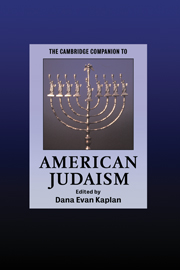1 - Preservation to innovation
Judaism in America, 1654–1880
from Part I - Historical overviews
Published online by Cambridge University Press: 28 May 2006
Summary
Judaism in America dates to 1654, when twenty-three Jewish refugees from Brazil arrived at the small Dutch settlement of New Amsterdam on Manhattan Island. Two Jewish individuals are known to have been present in the Dutch colony shortly before the newcomers arrived, but it is to the advent of the twenty-three, in flight from the Portuguese recapture of northeastern Brazil after more than twenty years of Dutch rule there, that a Jewish presence in North America is usually traced. Few of the group that arrived in 1654 remained in New Amsterdam for any lengthy period, but during their stay they acquired land for a cemetery in 1656, thereby creating the first Jewish religious institution in North America.
Of the twenty-three refugees who arrived from Brazil, the two who were already present on Manhattan Island, and a few others who appeared in New Amsterdam during the 1650s and early 1660s, only Asser Levy is known with certainty to have remained permanently. A well-known historical figure because of his challenge to Governor Peter Stuyvesant’s attempts to severely restrict the civic rights of the Jews in New Amsterdam (New York after the British seized it in 1664), Levy continued to live there until his death in 1682, serving as a bridge between the refugees who came in 1654 and later Jewish arrivals. By the time of his death, a sufficient number of Jews had settled in New York so that it is possible to date a truly permanent Jewish presence in the colony, and by extension to all the English colonies on the mainland of North America, to the decade of the 1680s. Indeed, the growing Jewish presence in New York necessitated the acquisition of additional land for a cemetery in 1682.
- Type
- Chapter
- Information
- The Cambridge Companion to American Judaism , pp. 23 - 42Publisher: Cambridge University PressPrint publication year: 2005



